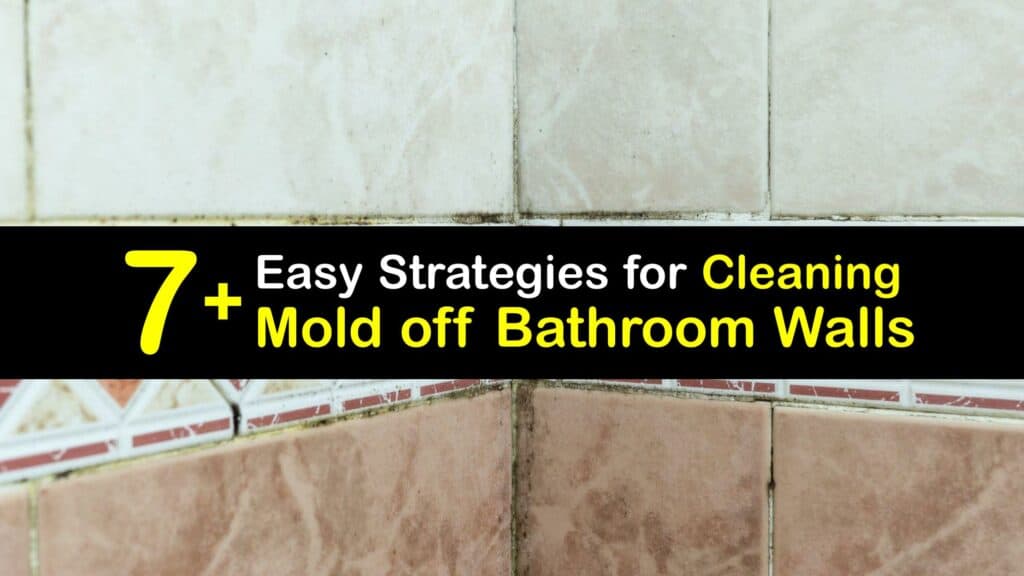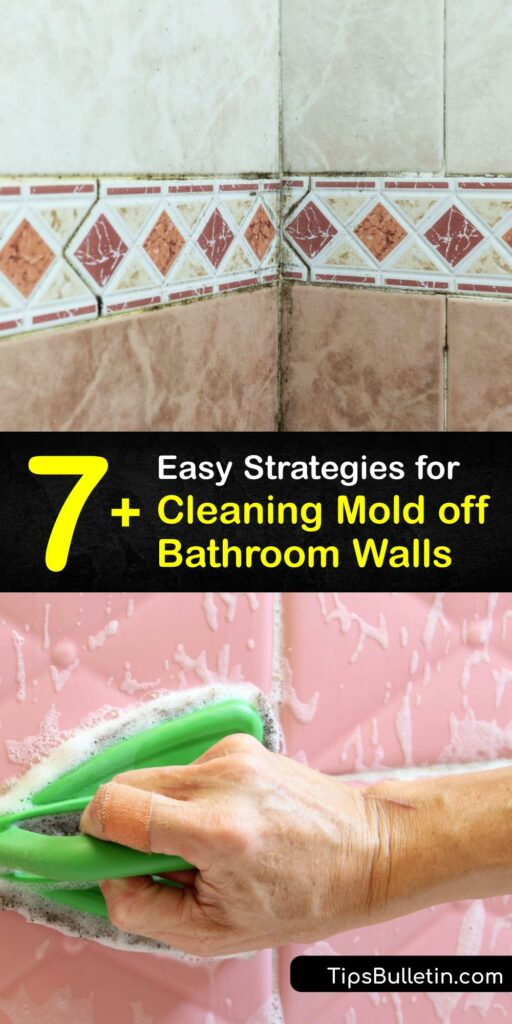Mold comes in many different forms. All molds found in bathrooms run the risk of being hazardous, though some are worse than others (black mold, in particular, tends to be very toxic). If your paint is peeling or you notice dark stains after water damage, it’s time to learn how to remove mold from a bathroom wall.
It’s imperative to begin cleaning bathroom mold on walls right away. Mold is frequently discovered in the grout between tiles, close to drains or air vents, on the wallpaper, or at the top of bathroom walls. Mold is well known for discharging spores that, when inhaled, cause anything from rashes and headaches to respiratory problems.
People more vulnerable to severe mold reactions include the very young or old or with compromised immune systems. Though it’s daunting to discover mold in your bathroom, you can fix it quickly. Find ways to clean mold out of shower caulk and walls with easy-to-follow protocols.

- How to Get Mold off Bathroom Walls
- What Causes Bathroom Mold Growth?
- Signs You Need Bathroom Mold Removal
- How to Remove Mold From a Bathroom Wall
- Chlorine Bleach for Cleaning Bathroom Mold on Walls
- Get Mildew off Bathroom Walls
- Removing Mold and Mildew From Bathroom Walls and Ceiling
- Commercial Products for Mold Removal
- Clever Tricks to Prevent Mold
How to Get Mold off Bathroom Walls
Are you struggling with how to remove mold from a bathroom wall? At some point, most of us are faced with cleaning bathroom mold on walls. Since hot air and moisture combine while we bathe, bathrooms are vulnerable to mold development.
Although mold remediation seems challenging, it’s straightforward with the right tools and knowledge. Peeling, cracking paint, dark marks on grout, and visible colonies on the wall are all signs of mold. Kill mildew in grout on your walls and keep your bathroom inviting and safe by understanding the signs and learning how to eradicate mold on walls.
What Causes Bathroom Mold Growth?
A bathroom is more likely to have a mold issue if it has a lot of excess moisture due to normal bathroom operations or water damage. Black mold growing in your shower and bathroom quickly establishes a mold population on the walls if conditions are conducive to growth, such as high humidity and inadequate ventilation.
Vapor from the bathtub or shower settles on the wall, condenses, and contributes to moisture. A damp wall eventually becomes a site for mold spores as time passes. Black mold and mildew not only make your bathroom ceiling and wall look dingy, they’re dangerous. Remove black spots on the bathroom ceiling to avoid a direct threat to your health.

Signs You Need Bathroom Mold Removal
If you’ve experienced water damage from a leaking roof or a broken pipe, you may have mold. Mold proliferates and develops in areas with high humidity or moisture in the air.
Enclosed spaces like bathrooms and basements are prime mold locations. Even without a significant precipitating event, bathrooms are prone to developing mold, and the walls and ceiling are the prime locations.
Inspect your bathroom often to ensure you catch mold in its early stages. Begin treatment as soon as you detect mold.
How to Remove Mold From a Bathroom Wall
Acetic acid kills mold quickly, making it easy to wipe away. White vinegar is efficient at killing mold since it has a high amount of acetic acid. Use it sparingly on painted drywall because the acid could cause peeling. Use the vinegar at its full strength, without watering it down, to get the best results in removing mold.
Erase mold by spraying it with white vinegar and allowing the vinegar to remain on the stain for one hour to eradicate any mold spores. Repeat the process and keep wiping up the mold spores with a towel so there are no traces of mold remaining.
White vinegar is a safe way to clean and eliminate mold infestation from the shower caulk, the shower wall, and the shower head. It also treats mold on a porous surface like foam tiles.
Chlorine Bleach for Cleaning Bathroom Mold on Walls
Chlorine bleach is an inexpensive option to prevent further mold development and eliminate spores present on your walls. For efficient mold spray cleaning, use a bleach solution with cold water. Avoid using bleach on painted walls, especially darker colors, as they may fade.
Shake the spray bottle containing the bleach and water until the two ingredients are thoroughly blended. Spray the affected area, so it is moist but not soaked with bleach. Use a brush or a scouring pad to strip away the mold remnants.
Reapplying the bleach spray, let it dry for 20 minutes, and remove it with a damp towel. Leave the wall to dry overnight, and revisit the location the following day to look for any lingering evidence of mold. Repeat the bleach treatment until you find no signs of mold.
Get Mildew off Bathroom Walls
To eliminate mold development in your bathroom without resorting to potentially hazardous and expensive chemical cleaners, create your own simple mold treatment by combining boric acid and distilled white vinegar.
This DIY spray cleaner is ideal for cleaning hidden and surface mold off your bathroom wall and grout. It works perfectly on a porous surface like foam tiles or plaster since it permeates the material and gets rid of the mold beneath it.
Keep pets and young children out of the room when using the spray, and only use it in areas with adequate ventilation. Shake the contents of the sprayer to mix them. Uniformly spray the wall, and immediately scrub off the top layer of mold using a brush or cloth.
Re-spray the wall until it is sufficiently damp, wait ten minutes, and clean it with a fresh rag. To get rid of hidden mold, let the spray soak into the wall overnight without rinsing. The spray loses potency after three hours, so it shouldn’t be reused or mixed with other mold removers.
Removing Mold and Mildew From Bathroom Walls and Ceiling
Lift mold off hard surfaces with hydrogen peroxide, including walls, bathroom fixtures, and ceilings. Find this reasonably priced disinfectant in your first aid kit or at the local drug store for the best mold remover for concrete basement walls and ceilings or anywhere that moisture is present.
Transfer 3% hydrogen peroxide into a spray bottle to saturate the affected area thoroughly. Wait ten minutes for the solution to settle, and give the region a good scrub with an old toothbrush to eliminate all traces of mold.
Wipe the wall with a moist towel. Because it is safe, doesn’t affect the environment, and doesn’t leave behind dangerous residue, hydrogen peroxide is an excellent alternative to bleach for cleaning mold.
Commercial Products for Mold Removal
Go to the hardware store in your neighborhood if you lack time to prepare a mold removal remedy or would rather use a store-bought product. There is a wide selection of mold removers available to address your mold problem.
If you prefer not to use potentially hazardous chemicals in your house, choose an option manufactured with natural ingredients. Before using a cleaner, read the directions first to apply it to the surfaces and objects you intend to clean effectively and safely.
Make a decision based on your cleaning preferences, and use the product while adhering to all safety guidelines.
Clever Tricks to Prevent Mold
Reducing the moisture and humidity in your bathroom is the most effective method for preventing mold growth on your walls. The shower stall and other equipment in the bathroom naturally create wet conditions.
Mold thrives in environments that are warm and damp. Several basic procedures significantly reduce the amount of moisture in the room and inhibit the formation of mold.
There is a natural accumulation of moisture in every bathroom. Taking measures to dry out the space helps avoid mold establishment or limits its progression if it is already present.
Trying to figure out how to get mold off bathroom walls can be scary. Mold isn’t just unsightly; it poses a health threat to you and your family if left unchecked.
Whether you had a household mold inspection and were notified of the issue, or found mold yourself, don’t despair. Use clever techniques to destroy the mold and leave your walls clean and your bathroom safe.

If you loved this enlightening article on how to remove mold from a bathroom wall, please share this mold remediation knowledge with your friends and family who are cleaning bathroom mold on walls on Pinterest and Facebook.